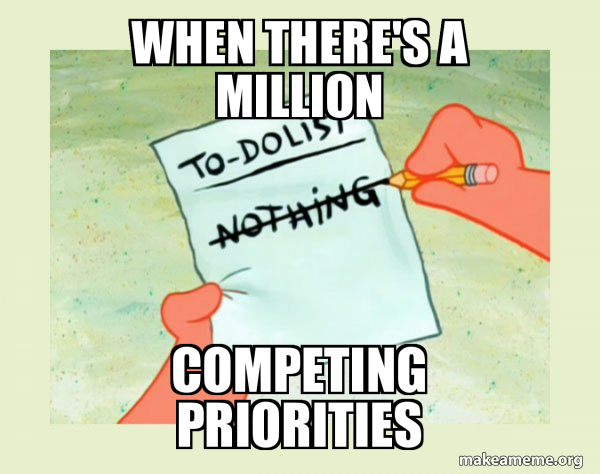Does the term ‘TAYA’ ring any bells? If you’re an executive or business owner who loves the idea of ‘They Ask, You Answer’ (TAYA) but hasn’t taken the leap, this article is for you. In this article, you’ll discover common reasons why businesses delay implementing TAYA after the initial excitement. You’ll explore both valid and detrimental reasons for delay and understand how postponing TAYA could harm your business more than you realise.
They Ask You Answer (TAYA) is a practical framework and sales and marketing philosophy based on a simple truth: when a prospect or customer asks a question, you provide an answer. By doing so, you establish yourself as the most trusted authority in your industry, leading to increased website traffic, leads, and sales, ultimately resulting in industry dominance.
Implementing TAYA in your business is more than simply implementing new strategies. It’s a company-wide initiative which aims to align your marketing and sales teams, help you hire the right people, and challenge everything your company already does with marketing and sales coaching.
While it can have a significant impact on your bottom line, you need to consider whether TAYA is right for you. In another article we explore whether TAYA is right for your business.
Hitting a Holding Pattern with TAYA
You might know that TAYA is right for you and yet find yourself in a holding pattern, unsure whether to make the changes necessary for your business or keep it at arm’s length.
In this article, you will learn common reasons why businesses delay TAYA, when those reasons are legitimate and when simply they are plain procrastinating excuses.
The Common Reasons Businesses Delay TAYA
The first step to start taking action and get off the delay-train is to understand and articulate why you’re delaying in the first place.
Often, a range of misconceptions and internal business challenges are what hold companies back from getting started with TAYA.
In particular, the common reasons why businesses delay TAYA include:
- Fear of increased workload
- Conflicting priorities
- Business maturity
- Disruptor product/too early
- Not enough pain/ambition
- Short-term thinking culture
Below you’ll find out whether you should move forward despite these reasons, or whether your reason is right to make you stand still.
They’re scared of the increased workload

Let’s get something out of the way: They Ask, You Answer is going to require work.
But why wouldn’t it?
Being the most dominant player in your industry doesn’t involve a secret algorithm or hiring a guru who has all the answers. It will take work and challenge you like nothing before.
Almost everyone gets TAYA, ‘it just makes sense!’ is the common response. It’s not a complicated framework. Not everyone is willing to do the work however.
Here’s the thing though. The businesses wanting to implement TAYA aren’t really aiming for 5-10% improvements in revenue growth. They’re looking at making substantial changes to their bottom line. In fact, it’s common for TAYA businesses to aim for 25-30%+ revenue improvement.
The businesses that are looking for growth like they’ve never seen before understand if they do what they always have, they will get what they always got.
The best way to look at TAYA is like a jumbo jet. It takes a lot of fuel to get a 747 off a runway. But once TAYA is up in the air – i.e. when the right team is trained, content is flowing, sales and marketing are working together – then you’re cruising and TAYA becomes the default norm.
Conflicting priorities and Analysis Paralysis

At first, perhaps you were excited about TAYA. You realised how many things you could implement to produce growth in your business.
The problem is that you’ve got so many things you want to do now and can’t decide on what you want to spend your time on, let alone TAYA.
You can’t decide, so you do nothing. And then you’re stuck.
This is one of the biggest reasons we see businesses holding back from implementing TAYA.
The problem with this is that businesses who don’t do anything for this reason are avoiding growth simply because they can’t decide on a path to move forward with.
If this is you, then you need to make a decision.
Ask yourself: Are we committed to being the most trusted voice in our industry? Are we willing to create transparent content even if we have to be the first in the space to do so (I.e. innovators)?
So, what’s the solution?
In short: A They Ask, You Answer coach could be a good option. A TAYA coach has worked with a plethora of businesses like yours and helped them get out of their own way by guiding them to the right priorities that will move the needle.
A coach will be an external facilitator, will help you define your priorities and then (via a stable of specialist coaches) will train your team on the content, sales, video, website etc components it needs to achieve TAYA Mastery
Now if you can’t afford a coach (i.e. make less than $2M annually) or don’t live in a timezone where coaching makes sense, commit to less fundamentals but do them properly. For example, hire a content writer to do 3 articles a week or learn assignment selling principles.
You’ll still get traction with TAYA by yourself, granted it will take longer and you need to be open to experimentation. This approach is better than nothing and comes down to your own expectation management.
Keep in mind however, that unsuccessful TAYA implementations makes it harder to get buy-in on future attempts so you may want to temper not only your own but the businesses expectations.
Successful implementation of TAYA can actually help you move towards implementing everything else that you want. TAYA isn’t simply a marketing and sales strategy – it’s a business philosophy and framework that can literally change the shape of your business – for the better.
So, if you’re stuck in a place of inaction simply because you’ve got too many competing priorities – then the first step is to resolve yourself to make a decision, either way. If TAYA is right for you forge ahead or don’t and manage your expectations.
Business maturity
Not all businesses are at the same stage in their development or have a mature business mindset. Some might lack clear vision, strategy, or the right people, making the idea of implementing TAYA daunting.
This isn’t limited to newer businesses. We’ve seen 30-year-old businesses struggling with some of these things, such as making key hires, which they find difficult because of their lack of clarity.
Sometimes it’s a family business that’s too set in their ways (many family businesses exceed with TAYA by the way) or it’s a lifestyle business where owners are not interested in growth.
The common thread here is the business is usually happy to tick along as it always has, knows it wants to grow but just isn’t great at defining SMART targets and unwilling to make the right hires.
A business that doesn’t have the maturity to strategically get out of its own way isn’t always hopeless. A TAYA workshop can often be a good low commitment kick. This can be done internally or externally facilitated.
TAYA is a great business compass and might be the antidote to your lack of clarity. It all comes down to maturity or commitment on maturing as a strategic business.
True Disruptor product or too early
TAYA can work wonders for disruptor products that don’t have defined markets, but this isn’t always the case.
Because TAYA is flexible and content can be focused on latent problems not yet met (i.e. when the iPhone or Netflix came out) the content strategy can focus on solving the problems the disruptor fixes e.g. the problems of physically renting DVDs.
But then there are disruptor products like e-commerce tech widgets that require more of a paid outbound strategy. That’s not to say content marketing won’t work, the market may just not respond to the content the way you expect.
If you do consider yourself a true disruptor product in an undefined category it’s best to check with a TAYA coach to help assess your suitability with TAYA.
Not enough pain, status quo is ok
Sometimes, a business’s worst enemy can be its own comfort. If everything is going “okay”, there might not seem to be an urgent need for change.
If the business is absolutely crushing it, is number one for Google for all related terms and is completely happy with its leads and closing rates then TAYA is more of a nice to have than something the business really needs.
It’s also about ambition. There is natural growth and then there’s exponential growth.
TAYA can provide the fuel to break free from the comfort zone and reach new heights of success. But the business ambition has to be there.
If you’re a business leader or marketer who loves TAYA but are in a business where the status quo is already crushing it and/or ambition is low, no amount of article sharing or newsletter forwards will likely make a difference.
Short-term thinking culture
The most successful businesses at any level don’t plan for the day or even the year, they create three, five and even ten-year strategic plans.
TAYA is not a fit for businesses that can’t make decisions today that don’t result in significant outcomes within a year.
While the first noticeable results can start to appear within three months, the real, transformative impact of TAYA takes a longer time – about 12 months.
There are more businesses in this category than you’d expect. It’s why businesses will resort to sales promotion after sales promotion or paying through the nose for paid media and lead aggregator sites like solar quotes or training.com.au.
This one overlaps with the business maturity reason because it’s essentially an inability to think strategically, get out for a moment of working in the business and instead more strategically on the business and its long-term growth viability.
There really isn’t an antidote here apart from realising that the sooner you start, the sooner you’ll reach the point where TAYA starts bringing substantial returns. The longer you keep waiting, the more likely you’ll find yourself kicking the can down the road leaving an opportunity for your competitor to better serve your prospects.
When Delay Might Be Justified
There are definitely valid reasons to delay TAYA.
If you’re still defining your business structure or you’re a start-up still establishing your footing, delay might be necessary. If you don’t have the funds, that’s another reason to delay.
However, these should not be used as perpetual excuses.
TAYA is top-down commitment and requires senior leadership buy-in if it ever has a chance to get off the ground. If you are struggling to get C-Suite on the hook, then gifting them the best-selling book They Ask, You Answer is a great first step.
Perhaps you aren’t yet ready to implement TAYA. If you feel this is you, then you should read our article on ‘Is TAYA right for your business?’
The Consequences of Delaying TAYA
“In any moment of decision, the best thing you can do is the right thing, the next best thing is the wrong thing, and the worst thing you can do is nothing”.
Theordore Roosevelt
There are risks associated with any action we may take. However, the cost of inaction may be far greater, and when you’re stuck between implementing TAYA and delaying, the costs may be great for your business.
Every passing day, week, and month that your business goes without implementing TAYA is an opportunity lost. It’s a potential customer who didn’t connect with your brand, a potential sale that slipped through the cracks, a missed opportunity for you to position yourself as an industry authority.
This urgency is even more pronounced when you consider the timeline of results from implementing TAYA.
While the first noticeable results can start to appear within three months, the real, transformative impact of TAYA takes a longer time – about 12 months.
The sooner you start, the sooner you’ll reach the point where TAYA starts bringing substantial returns. The longer you keep waiting, the more likely you’ll find yourself kicking the can down the road while other companies implement TAYA and experience exponential growth.
In reality, TAYA is more about strategic planning and decision-making than hands-on work (at least from your side).
It’s about identifying the right people for the right roles and delegating effectively. For example, you’ll need to hire the right content manager in order to produce content that answers buyer questions and generates sales. And, you’ll need to hire the right sales rep, in order to take full advantage of the sales practices we share in coaching.
Ultimately, this means that your job is to delegate effectively. If you believe you don’t have the time to do that, then that’s a sign of a bigger problem.
The First Step to Get Started With TAYA
How can you kickstart your TAYA journey? Do one or more of the following:
- Read this book and get your key stakeholders to do the same
- Get leadership buy-in with a TAYA Workshop
- Educate yourself and your peers with a free or paid course on IMPACT+
- Prioritise one TAYA-related task for the next 90 days
- Remember, TAYA Coaching offers flexible solutions to fit your needs. You don’t need to take on everything at once. Get in touch with us here to stop kicking the can down the road with TAYA
Remember, inaction has a cost, and with TAYA, that cost compounds over time.
Just. Do. Something.
Delaying the implementation of TAYA is the same as delaying the realisation of your business’s potential.
It means settling for ‘okay’ when ‘excellent’ is within your reach. It means losing out on opportunities to connect, engage, and build lasting relationships with your customers.
Recap & Summary
If you understand TAYA, believe it can make an impact and are in a business generating revenue of $2.5 million or higher, the time to implement TAYA is now. Not because it’s a trend, not because everyone else is doing it, but because it’s hard and only hard can transform your business’s trajectory.
TAYA can help you build a strategic moat against your competition at a level where they will need years to catch up.
The journey towards TAYA may appear challenging, but at every step, you can find assistance in the resources we mentioned. Whether it’s free/affordable courses, workshops, or comprehensive TAYA Mastery coaching, there is ample support available to help you along the way.
It’s time to stop kicking the can down the road and start your TAYA journey. Get in touch here.













